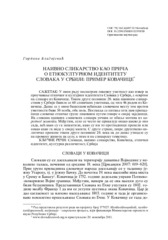Приказ основних података о документу
Наивно сликарство као прича о етнокултурном идентитету Словака у Србији: пример Ковачице
Naive Art as a Story about the Ethno/Cultural Identity of Slovaks in Serbia: the Example of Kovačica
| dc.contributor | Благојевић, Гордана | |
| dc.creator | Благојевић, Гордана | |
| dc.date.accessioned | 2020-04-04T16:27:37Z | |
| dc.date.available | 2020-04-04T16:27:37Z | |
| dc.date.issued | 2012 | |
| dc.identifier.issn | 0352-5732 | |
| dc.identifier.uri | http://www.maticasrpska.org.rs/stariSajt/casopisi/drustvene_nauke_139.pdf | |
| dc.identifier.uri | https://dais.sanu.ac.rs/123456789/7594 | |
| dc.description.abstract | У овом раду посматрам ликовну уметност као извор за проучавање етничког и културног идентитета Словака у Србији, с освртом на сликаре из Ковачице. Током друге половине 20. века наивним сликарством у Србији бавило се 60 словачких уметника, од тога 46 родом из Ковачице. Данас се у овом банатском већински словачком месту том врстом уметности бави 30 особа, оба пола. Поставља се питање шта нам припадници словачке етничке групе ликовним путем говоре о својој заједници. На сликама наивних словачких сликара уочава се обиље мотива из народног живота. Међутим, село се често не приказује онако какво је оно сада, већ како су га запамтили, како су им то претходници пренели или онако како га виде у својој машти. С друге стране, шире друштвено- политичке промене током друге половине 20. века па до данас утицале су на промену живота на селу, а тиме и на сликарску тематику. | sr |
| dc.description.abstract | In this paper, painting is observed as a source for studying the ethnic and cultural identity of Slovaks in Serbia, with the retrospective view to the painters from Kovačica. During the second half of the 20th century there were 60 Slovakian artists in Serbia who dealt with the Naive Art, and 46 of them were from Kovačica. Today, in this majority Slovakian village in Serbia there are 30 people of both sexes who deal with the Naive Art. What do the members of the Slovak ethnic group tell us about their community through their art? Many motives from folk life can be observed in the paintings of Slovakian naive artists. However, the village is not often shown as it is today, but as it was remembered or depicted by the predecessors. On the other hand, multiple social and political changes during the second half of the 20th century, which have continued until today, influenced and changed village life, and also the subject matter of the Art. | en |
| dc.language.iso | sr | sr |
| dc.publisher | Нови Сад : Матица српска | sr |
| dc.relation | info:eu-repo/grantAgreement/MESTD/Basic Research (BR or ON)/177027/RS// | sr |
| dc.rights | openAccess | sr |
| dc.source | Зборник Матице српске за друштвене науке | sr |
| dc.subject | Словаци | sr |
| dc.subject | наивно сликарство | sr |
| dc.subject | Ковачица | sr |
| dc.subject | етнички идентитет | sr |
| dc.subject | културна различитост | sr |
| dc.subject | Србија | sr |
| dc.subject | Slovaks | sr |
| dc.subject | Naive Art | sr |
| dc.subject | Kovačica | sr |
| dc.subject | ethnic identity | sr |
| dc.subject | cultural differences | sr |
| dc.subject | Serbia | sr |
| dc.title | Наивно сликарство као прича о етнокултурном идентитету Словака у Србији: пример Ковачице | sr |
| dc.title | Naive Art as a Story about the Ethno/Cultural Identity of Slovaks in Serbia: the Example of Kovačica | en |
| dc.type | article | sr |
| dc.rights.license | ARR | sr |
| dcterms.abstract | Blagojević, Gordana; Naivno slikarstvo kao priča o etnokulturnom identitetu Slovaka u Srbiji: primer Kovačice; | |
| dc.rights.holder | Матица српска | sr |
| dc.citation.spage | 185 | |
| dc.citation.epage | 195 | |
| dc.citation.volume | 63 | |
| dc.citation.issue | 139 (2) | |
| dc.identifier.doi | 10.2298/ZMSDN1239185B | |
| dc.description.other | Тема броја : Идентитет и мултикултуралност : Србија и окружење на почетку трећег миленијума (ур. Гордана Благојевић, стр.139–248) | sr |
| dc.type.version | publishedVersion | sr |
| dc.identifier.fulltext | https://dais.sanu.ac.rs/bitstream/id/29852/bitstream_29852.pdf | |
| dc.identifier.rcub | https://hdl.handle.net/21.15107/rcub_dais_7594 |

